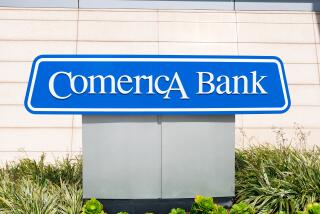Nation’s Thrifts Lose $3.7 Billion in 2nd Quarter : Higher Interest Rates, Real Estate Writedowns Blamed by Regulators
- Share via
WASHINGTON — The savings and loan industry, buffeted by rising interest rates and increased writedowns on bad real estate investments, suffered losses of $3.7 billion during the second quarter, federal regulators reported Tuesday.
The losses will continue as the industry struggles through a massive restructuring, with hundreds of institutions likely to disappear through shutdowns and sales, predicted James Barth, chief economist for the Office of Thrift Supervision.
Total losses for the industry rose from the first-quarter level of $3.5 billion because higher interest rates on deposits drove up the cost of doing business for all thrifts--profit-making institutions as well as insolvent S&Ls.;
In addition, the insolvent thrifts under government control were subject to increasingly stringent evaluation of their assets, with auditors forcing deep writedowns in the value of real estate holdings.
Devastation in Texas
Two California S&Ls;, Lincoln Savings & Loan and Gibraltar Savings & Loan, amassed a combined loss of $1.2 billion during the second quarter, Barth said at a news conference at which he announced the industry’s second-quarter earnings. Both are being run under government conservatorships, and most of their losses came from writedowns. The flood of red ink from these two institutions produced an overall loss of $1.5 billion for the San Francisco Home Loan Bank district, which includes California, Nevada and Arizona.
“We see a couple of institutions rivaling the problems in Texas,” Barth said. But there is no problem in California “across the board.” The district was second only to the Dallas Home Loan Bank District, which reported losses of $1.6 billion, reflecting the devastation of the Texas thrift industry.
The San Francisco district had the nation’s highest cost of funds, 8.75%, as S&Ls; were forced to pay significantly higher rates to halt a loss of deposits, according to Barth. “Large institutions were experiencing deposit outflows,” he said. The withdrawals were prompted by the lure of higher rates from alternative investments, such as money market funds, and nervousness among depositors caused by publicity about the thrift crisis.
Barth painted a portrait of a schizophrenic U.S. thrift industry, split between a group of “healthy solvent institutions” and a troubled segment that will dwindle and disappear.
Most S&Ls; are profitable: 1,995 institutions enjoyed earnings of $1.2 billion. But their profits are overshadowed by the huge deficits of the 939 unprofitable S&Ls;, where losses totaled $4.9 billion.
Industry Is Shrinking
The government has already seized 262 financially crippled institutions and could eventually control as many as 600 thrifts, Barth said. Even more significant, new capital standards, requiring S&Ls; owners to contribute more of their own funds to the business, will hasten the shrinkage of the industry, Barth said.
“There is no concern about the safety of insured deposits,” he added, because Congress and the President have demonstrated their absolute commitment to the safety of the federal insurance fund, which guarantees deposits up to $100,000. But whether the deposits will remain in the same institutions is very much in question as the industry goes through a wave of mergers and shutdowns.
The thrift industry will need $30 billion in new capital, a staggering total for a financially troubled business, to meet the standards required under the legislation signed this month by President Bush. The new law, which provides funds to shut down troubled S&Ls; and pay off their depositors, imposes financial standards aimed at discouraging the careless investments that generated the current crisis.
If S&Ls; cannot raise the capital to stay in business as independent institutions, many will disappear, being purchased by financially healthy S&Ls;, banks or other corporate and individual investors.
Awaiting Instructions
The shrinkage of the industry will accelerate now that Bush has signed the S&L; legislation, which provides $50 billion to close insolvent thrifts. Regulators are poised to shut down five major insolvent institutions but are awaiting instructions from the policy-making board of top federal officials, C. C. Hope, Jr., a director of the Federal Deposit Insurance Corp. said Tuesday.
“We had about five cases ready to move when the bill was signed,” he said during a lunch at which reporters heard from top FDIC regulators. But the Resolution Trust Corp.’s Oversight Board “said we should not do major” thrift actions, L. William Seidman, the FDIC chairman, said. “We haven’t been given permission to do more.”
The Oversight Board, consisting of Treasury Secretary Nicholas F. Brady, Federal Reserve Chairman Alan Greenspan, Secretary of Housing and Urban Development Jack Kemp, and a public member to be named later, is the policy-making body for the Resolution Trust Corp., which will dispose of crippled thrifts and their assets. The RTC work will be performed by personnel from Seidman’s Federal Deposit Insurance Corp.
Rep. Bruce Vento (D-Minn.) was appointed Tuesday as chairman of a congressional task force to oversee the RTC’s work of cleaning up the industry. Vento was selected by Rep. Frank Annunzio (D-Ill.), chairman of the House Banking Committee’s financial institutions subcommittee.
More to Read
Inside the business of entertainment
The Wide Shot brings you news, analysis and insights on everything from streaming wars to production — and what it all means for the future.
You may occasionally receive promotional content from the Los Angeles Times.










